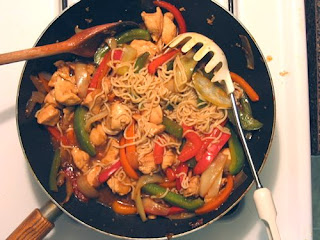For the first post-insect dish, I decided to try shirataki noodles. There are several different kinds of these guys, but recently, the tofu variety from House Foods has become particularly huge, thanks to exhaustive endorsements from Hungry Girl.
When it comes to dieters and folks with allergies, there are definite advantages to choosing shirataki noodles over pasta or rice. House Foods brand is vegan, gluten-free, cholesterol-free, and relatively guilt-free. Each ½-cup serving comes out to about 20 calories, and sources say they generally take well to Asian-style dishes. While there’s a rinsing process, the noodles don’t need to be boiled for any length of time, making them conveniently heat-n-serve.
However (and there’s always a however), there are drawbacks. First, some claim shirataki noodles aren’t much good in Italian dishes. Second, the lighter caloric load means they won’t necessarily fill you up, either.
Finally – and most significantly - there’s the price. Shirataki noodles come in 8-oz. bags filled with water (for preservation). After draining, this is just about a single cup of actual noodles. My Key Food charges $1.50 for this on sale, or $0.75 per ½-cup serving. Of noodles. Just noodles.
To compare, a single 1-lb. box of Ronzoni thin spaghetti costs $0.66 on sale, and produces about four cups of cooked pasta. That’s roughly $0.08 per ½-cup serving. Rice noodles are more expensive, at about $0.45 per ½-serving, but are still a bargain comparatively. I’m not even gonna get into rice itself, because my brain hurts now.
Of course, the deciding factor for any food should be its taste. And in that sense, the shirataki noodles were okay. Not good, not bad. Just okay. They barely have a flavor, actually. I prepared them with peppers, onions, chicken, and Cook’s Illustrated Orange Sesame Stir Fry Sauce, and they blended seamlessly into the mix. I suspect they’d go very well with ramen-style dishes, too.
Ultimately, my verdict is this: unless you have allergies, certain dietary restrictions, or are a VERY beginning dieter, shirataki noodles may not be the best buy. There are tastier, significantly cheaper ways to cut calories.
Have a great weekend everyone. Monday, we're back to bug-free posting. (To repeat: wood, she is being knocked on.)
Orange Sesame Stir Fry with Shirataki Noodles
Serves 3 or 4
Adapted from Cook's Illustrated Best 30-Minute Recipe.

½ cup orange juice
¼ cup soy sauce, plus 1 separate teaspoon
¼ cup low-sodium chicken broth
2 teaspoons toasted sesame oil
2 teaspoons cornstarch
2 tablespoons vegetable oil
1 lb. skinless, boneless chicken breast, cut into 1-inch pieces
3 bell peppers (any kind), sliced into strips
1 medium onion, sliced into thick strips
1 tablespoon grated fresh ginger
2 or 3 garlic cloves, minced
1 bag House Foods shirataki noodles, drained and rinsed
1) In a small bowl, combine orange juice. 1/4 cup soy sauce, broth, sesame oil, and cornstarch. Whisk it all together. Set aside. In a separate medium bowl, coat chicken in the other 1 teaspoon of soy sauce.
2) In a large skillet or wok, heat 2 teaspoons veggie oil over medium-high heat. Cook the chicken until browned. Using tongs, remove it to a dish
3) Add 1 tablespoon veggie oil to the skillet. Add veggies. Saute them until they're crisp-tender, another few minutes.
4) Spread veggies around the perimeter of the pan and add the remaining 1 teaspoon of veggie oil. Add garlic and ginger. Cook 30 to 60 seconds, until fragrant.
5) Add chicken back to skillet and stir everything together. Heat until warmed, a minute or two.
6) Re-whisk orange-sesame sauce, and add it to skillet. Bring everything up to a simmer. Cook for another minute or two, until the sauce is thickened. (It will thicken. Don't worry.) Add noodles and warm through. Serve.
Approximate Calories, Fat, and Price Per Serving
Three servings: 389 calories, 15.4 g fat, $1.87
Four servings: 291 calories, 11.6 g fat, $1.40
Calculations
½ cup orange juice: 55 calories, 0 g fat, $0.16
¼ cup soy sauce, plus 1 separate teaspoon: 37 calories, 0 g fat, $0.40
¼ cup low-sodium chicken broth: 22 calories, 0.75 g fat, $0.06
2 teaspoons toasted sesame oil: 80 calories, 9 g fat, $0.12
2 teaspoons cornstarch: 20 calories, 0 g fat, $0.02
2 tablespoons vegetable oil: 256 calories, 29 g fat, $0.18
1 lb. skinless, boneless chicken breast, cut into 1-inch pieces: 497 calories, 5.4 g fat, $1.69
3 bell peppers (any kind), sliced into strips: 98 calories, 1 g fat, $1.09
1 medium onion, sliced into thick strips: 46 calories, 0.1 g fat, $0.24
1 tablespoon grated fresh ginger: 5 calories, 0 g fat, $0.03
2 or 3 garlic cloves, minced: 11 calories, 0 g fat, $0.12
1 bag House Foods shirataki noodles, drained and rinsed: 40 calories, $1.50
TOTAL: 1167 calories, 46.25 g fat, $5.61
PER SERVING (TOTAL/3): 389 calories, 15.4 g fat, $1.87
PER SERVING (TOTAL/4): 291 calories, 11.6 g fat, $1.40






0 comments:
Post a Comment